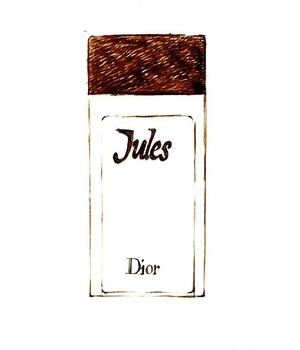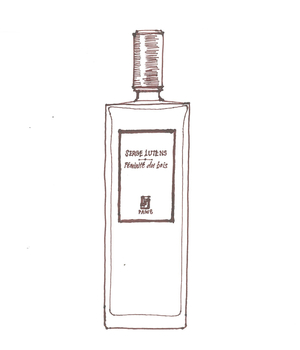Tagged With ‘Kouros’
Christian Dior
Jules
21 August, 2015
 Sage isn’t everyone’s favourite herb, though turkey stuffing wouldn’t the same without it. It’s used less often in perfumery than in cooking, but Jules shows what a great ingredient it can be in the hands of a brilliant perfumer.
Sage isn’t everyone’s favourite herb, though turkey stuffing wouldn’t the same without it. It’s used less often in perfumery than in cooking, but Jules shows what a great ingredient it can be in the hands of a brilliant perfumer.
The ‘nose’ in this case was Jean Martel, who worked for the French fragrance company Givaudan in the 1970s and 1980s and deserves to be far better known, not least because he also created that 1970s classic, Paco Rabanne for Men.
Jules was launched in 1980, with a brilliant advertising campaign featuring posters by René Gruau, arguably the greatest fashion illustrator of the last century, which helped the first bottles sell out in record time. Martel combined sage (which has a slightly catty smell) with cedar and other things like wormwood, lavender and bergamot. To me the result smells like sage and slightly peppery leather, though there’s a long list of other ingredients, including cumin, sandalwood, oakmoss, jasmine, musk and rose.
Despite its initial success, Jules has since been overshadowed by the success of Kouros, which was launched the following year. Created for Yves Saint Laurent by the brilliant Pierre (Cool Water) Bourdon, Kouros shares Jules’ clean / dirty / sexy character, and both scents belong to the same fragrance ‘family’, the fougères – a style of perfumes, usually aimed at men, based on a combination of lavender and coumarin (originally derived from tonka beans but usually synthesised).
Of course, Kouros’ ongoing popularity may be because it’s inherently superior to Jules, but actually I think it’s more to do with the fact that over the years Kouros has benefited from regular advertising, while Dior seems to have forgotten that Jules ever existed, which I think is a terrible shame.
To make matters worse, while you can buy Kouros pretty much anywhere, Jules has become ridiculously hard to find: I don’t know anywhere in the UK that sells it, and even in Paris the only place that seems to stock it is the department store Bon Marché, though you can buy it from Dior’s French website. Given Dior’s apparent lack of interest, it’s a wonder it hasn’t been discontinued, but I’m glad it’s still on sale, even if it’s now a rarity.
I can only hope that one day they decide to invest in promoting it again and making it available to all – but in the meantime if you want something special that very few other people will have, get over to Bon Marché.
Serge Lutens
Féminité du Bois
20 October, 2014
 Féminité du Bois was launched in 1992 for Shiseido, the Japanese beauty company for which Serge Lutens created many striking ad campaigns, and which backed him in the launch, the same year, of his super-chic Salons du Palais Royal. It was in its original incarnation that I first encountered Féminité du Bois, and what first caught my eye was the design of the bottle – a lovely teardrop-shaped glass container, designed by Lutens himself.
Féminité du Bois was launched in 1992 for Shiseido, the Japanese beauty company for which Serge Lutens created many striking ad campaigns, and which backed him in the launch, the same year, of his super-chic Salons du Palais Royal. It was in its original incarnation that I first encountered Féminité du Bois, and what first caught my eye was the design of the bottle – a lovely teardrop-shaped glass container, designed by Lutens himself.
Sadly that style of bottle disappeared in 2009, when Lutens left Shiseido and set up in his own name; the perfume went with him, repackaged in his signature bottles – a tall, slim, rather flat rectangular design, stylish in its own right but not as poetic as Shiseido’s original.
Recommending a perfume called Féminité du Bois to men might sound like a rather capricious (not to say perverse) enterprise, but many great fragrances transcend the gender associations that their names, and their marketing, impose on them, and this is one of the most beautiful fragrances I know.
Floral scents may be thought of as quintessentially feminine, and it would take a very confident man to wear something that smelled predominantly, say, of jasmine or of rose. Yet some of the most popular men’s perfumes have flowers in them – violets in Grey Flannel, for example, or jasmine in Eau Sauvage.
Féminité du Bois is, if you like, a mirror image of these kinds of men’s fragrance: a nominally female fragrance made more, rather than less alluring by the addition of elements that are generally associated with the opposite sex. The master stroke, in this case, is the combination of sweet, rather girly smells – violets and plum (the fruit rather than the flower) – with the masculine, pencil-shaving smell of cedar wood.
It’s one of those combinations that works so well that you wonder why nobody had thought of it before, but I guess that’s the mark of genius – in this case the genius of British perfumer Christopher Sheldrake (who worked on many of the Serge Lutens fragrances before getting snapped up by Chanel) and the legendary Pierre Bourdon (Cool Water, Kouros and many others).
The first time I tried out Féminité du Bois my reaction was ‘This smells exactly like Bel Ami’. Which is to say, like pencil shavings, which is the main – and very appealing – impression you get from the classic Hermès scent. But moments later you realise that there’s more going on inside the woodiness, and the warmth and slight sweetness of plum, violets and spices blend with the cedar to make an effortlessly satisfying whole.
Luxury can mean different things to different people: for some, bling is the thing, but for others luxury means high quality and discretion – and that’s the kind of luxury Féminité du Bois suggests to me. It’s neither brash nor overpowering, which makes it eminently wearable, but nor is it faint or feeble. Try it for yourself and I hope you’ll see what I mean.